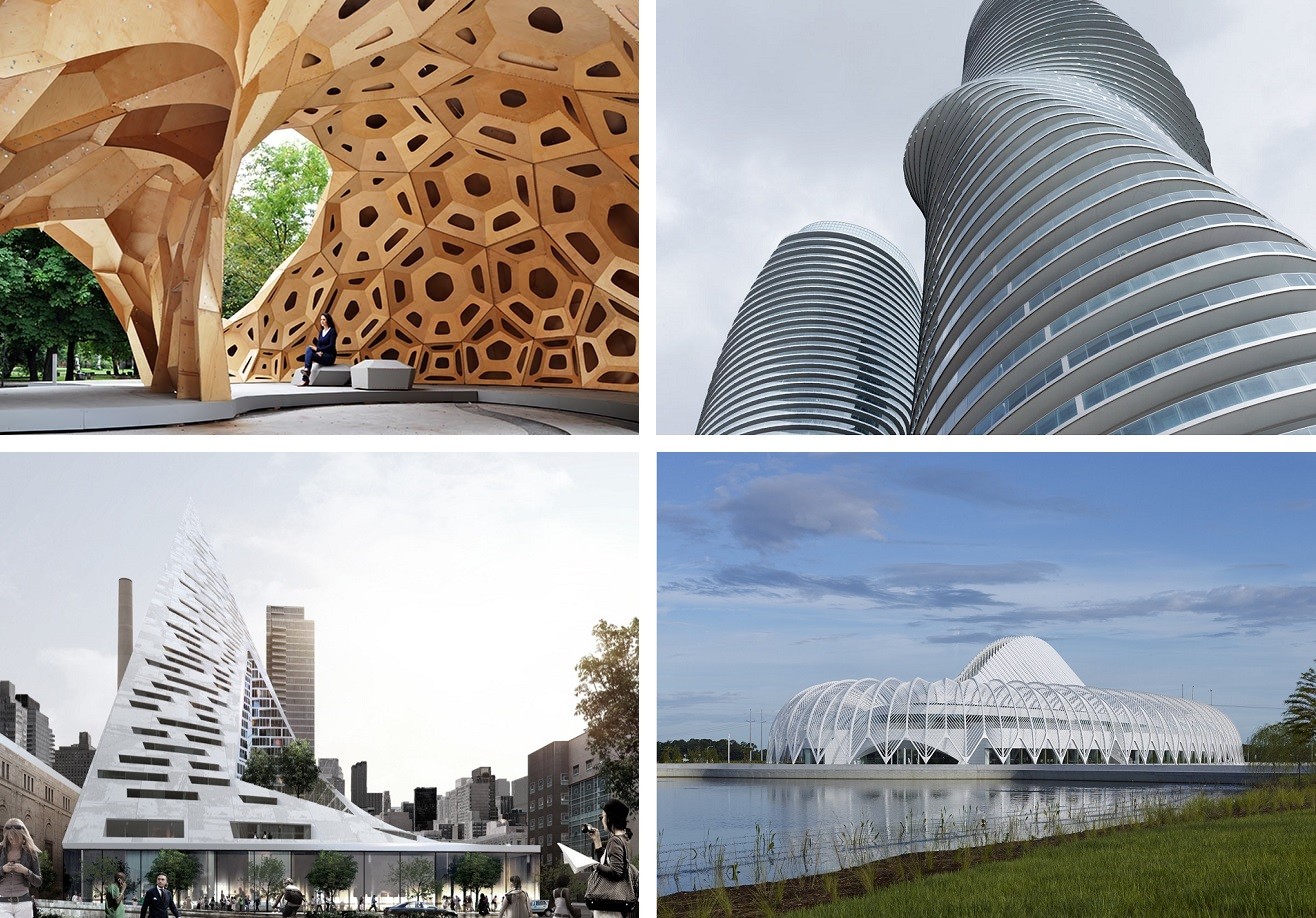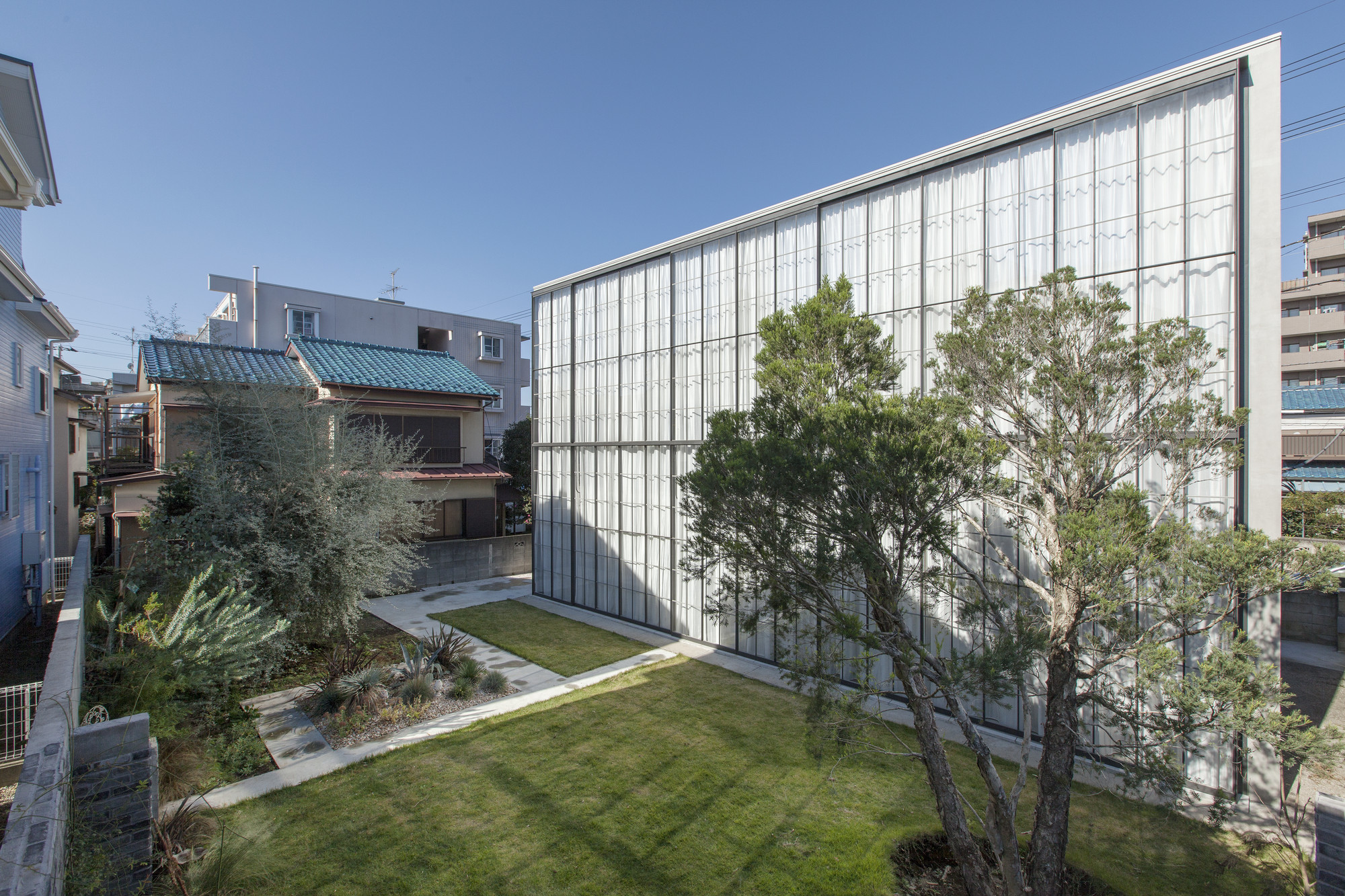BLUEPRINT is the latest exhibition on display at the Storefront for Art and Architecture in New York. Curated by Sebastiaan Bremer, Florian Idenburg and Jing Liu, the exhibition features 50 blueprints from participating artists and architects, ranging from as far back as 1961 to 2013.
BLUEPRINT: Curated by Sebastiaan Bremer and Florian Idenburg & Jing Liu of SO – IL
Defining a More Purposeful Architecture: A Guide to Current Architectural Trends

The current state of architectural design incorporates many contemporary ideas of what defines unique geometry. With the advent of strong computer software at the early 21st century, an expected level of experimentation has overtaken our profession and our academic realms to explore purposeful architecture through various techniques, delivering meaningful buildings that each exhibit a message of cultural relevancy.
These new movements are not distinct stylistic trends, but modes of approaching concept design. They often combine with each other, or with stylistic movements, to create complete designs. Outlined within this essay are five movements, each with varying degrees of success creating purposeful buildings: Diagramism, Neo-Brutalism, Revitism, Scriptism, and Subdivisionism.
Village Health Works Staff Housing / Louise Braverman

-
Architects: Louise Braverman
- Area: 6000 ft²
- Year: 2013
-
Professionals: Liam O’Hanlon Engineering, Plus Group Consulting Engineering PLLC
Iwan Baan: No Filter

Cultured, one of the leading art, architecture and design magazines, has shared with us part of the 16-page photo essay “No Filter” by Iwan Baan that is being featured in its Winter Issue, on stands now. Enjoy!
If you pore endlessly over images of architecture the way we do, chances are you’ve been drooling over work captured by Iwan Baan. Though he’s adamant that he not be referred to as an “architectural photographer,” Baan has probably captured more buildings, pavilions, residences and just about every other structure in between than any other single lensman. Yet it is Baan’s background in documentary photography that most influences his work. “I choose my projects not so much for the architecture, but for its relationship with the city around it and how people respond to it,” says Baan. “I’m trying to tell the story of the built environment—the places where we live.” Here, Baan tells the story behind 11 projects completed this year, and two others that he has a personal connection to.
“I love great architecture that is very specific for its site and client, it’s for an architect always a dance between him, a site and a client. Here, Gehry was given complete freedom to design every detail, every nook and cranny of a building for Bernard Arnault to house his art collection.”
Read on for more quotes and images by the renowned Iwan Baan.
BIG Returns to the National Building Museum with “HOT TO COLD: an odyssey of architectural adaptation”

On the heels of its summer blockbuster indoor maze, which attracted more than 50,000 visitors, the international design firm BIG-Bjarke Ingels Group (BIG) returns to the National Building Museum this January with a behind-the-scenes look at its creative process. The exhibition, HOT TO COLD: an odyssey of architectural adaptation, takes visitors from the hottest to the coldest parts of our planet and explores how BIG´s design solutions are shaped by their cultural and climatic contexts. More than 60 three-dimensional models will be suspended at the second-floor balconies of the Museum’s historic Great Hall in an unprecedented use of this public space.
2014 AR Emerging Architecture Awards Winners Announced

The Architectural Review has selected the winners of the 2014 AR Emerging Architecture Awards. Now in their 16th year, they are one of the most prestigious awards for young architects and emerging practices. Past winners have included Sou Fujimoto, Thomas Heatherwick, Sean Godsell, Jurgen Mayer H. and Li Xiaodong.
Given to completed projects, entries can include buildings, interiors, landscaping, refurbishment, urban projects, temporary installations, furniture and product designs. This year the jury was comprised of Catherine Slessor, Hilde Daem, Li Xiaodong, Steven Holl and Will Alsop.
Read on after the break for this year’s Emerging Architecture Award winners.
Arcus Center for Social Justice Leadership / Studio Gang
_Hedrich_Blessing_015.jpg?1418271901)
-
Architects: Studio Gang
- Area: 10000 ft²
- Year: 2014
A Look Inside SelgasCano's First UK Project

In an article for The Observer Rowan Moore examines 'Second Home', a newly opened "creative hub" in London designed by Spanish practice SelgasCano, who were recently announced as the designers of the 2015 Serpentine Pavilion. For Moore the project, which is the practice's first building in the UK, offers a "lightness and grace as well as invention, and an awareness of when to stop." The building is designed to be fluid, allowing start-up creative businesses to move in and move out as and when their business model dictates. Heavy tables can emerge from the floor, and 'roaming zones' facilitate creative thought. According to Moore's review, there "are no water-coolers, no kitchenettes, [and] no microwaves."
Iwan Baan: Going Up
While you might not recognize him, you know his work; much of today’s most famous buildings are being archived through the lens of Iwan Baan. As the go-to photographer for many of the world’s leading architects, Baan is constantly on the move and exploring new places. And, just as he describes in the NOWNESS video above, he has found that the best way to understand a new city is to “go up” and view it from above.
The Work of SelgasCano, the 2015 Serpentine Pavilion Designers

The latest designer of the prestigious Serpentine Gallery Pavilion has been named as SelgasCano, the Spanish practice known for their use of the latest synthetic materials and new technology. The Serpentine Pavilion, which has grown to become one of the most visited annual architecture attractions in the world, aims to provide architects who have never built in the UK their first chance to do so. In the past, this has led to pavilions by globally-recognized names such as Frank Gehry, Zaha Hadid, Rem Koolhaas, Oscar Niemeyer, and Peter Zumthor, but in recent years the Serpentine Gallery seems to have changed course a little, instead bringing lesser-known, emergent stars to a much wider audience. This was true of Smiljan Radić and his 2014 pavilion, and will likely prove true for the duo of José Selgas and Lucía Cano.
Although designs for the 2015 pavilion will not be released until February, SelgasCano have promised "to use only one material... the Transparency," adding that "the most advanced technologies will be needed to be employed to accomplish that transparency." This coy description perhaps calls to mind the design of their own office, a partially sunken tube of a building with one side made entirely of curved glass, which won them widespread recognition in 2009.
To give a better idea of the design style that SelgasCano will bring to the 2015 Serpentine Pavilion, we've rounded up a number of their major projects for your viewing pleasure, after the break.
SelgasCano to Design 2015 Serpentine Pavilion

Spanish architects SelgasCano have been selected to design the 2015 Serpentine Gallery Pavilion, which has become one of the top-ten most visited architectural and design exhibitions in the world. The Pavilion will stand in Kensington Gardens during the summer and serving as a multi-purpose social space.
The award-winning studio is led by José Selgas and Lucía Cano and will be the first Spanish architecture practice to design a Serpentine Pavilion, with AECOM once again providing the engineering and technical design services. Although designs will not be revealed until February 2015, SelgasCano had this to say about designing the pavilion:
This is an amazing and unique opportunity to work in a Royal Garden in the centre of London. Both aspects, ‘Garden’ and ‘London’, are very important for us in the development of this project. We are in the middle of a garden, a ‘Royal’ garden indeed, once divided in two and separated by a Serpentine. That garden clings in the middle of London. Garden and London (which best defines London?) will be the elements to show and develop in the Pavilion. For that we are going to use only one material as a canvas for both: the Transparency. That ‘material’ has to be explored in all its structural possibilities, avoiding any other secondary material that supports it, and the most advanced technologies will be needed to be employed to accomplish that transparency. A good definition for the pavilion can be taken from J. M. Barrie: it aims to be as a ‘Betwixt-and-Between’.
Surface Mag Interviews Liz Diller on Architecture, Art, and Early "Aha" Moments

Below is an excerpt of the cover story of this month’s Surface magazine: an in-depth interview with Elizabeth Diller, published online for the first time here on ArchDaily.
The 35-year career of Elizabeth Diller, a founding partner of the New York–based architecture studio Diller Scofidio + Renfro, is a study of contrasts: conceptual and pragmatic, temporary and permanent, iconoclastic and institutional. After graduating from Cooper Union in 1979, Diller started her practice mounting temporary installations with her partner and future husband, Ricardo Scofidio, their interests leaning closer to art and theory than conventional buildings and construction. Today the duo—along with Charles Renfro, who became a partner in 2004—is responsible for some of the most important architectural projects in the country. DS+R counts Boston’s Institute of Contemporary Art (completed in 2006) and a makeover of New York’s Lincoln Center (finalized in 2012) among its highest-profile works. Especially influential, at least among architects and academics, has been the firm’s unbuilt Slow House (1991), a proposal for a residence on Long Island, New York, renowned for its examination of how we see in a media-saturated world.
One notices sharp contrasts not just in the firm’s work history but in its public reception as well. Widely lauded for repurposing a dilapidated elevated railway into New York City’s beloved High Line park (the third phase opened in September), DS+R received heavy criticism this year for its involvement in a major expansion proposal for the Museum of Modern Art. The museum’s plans included the demolition of its little-guy neighbor, the American Folk Art Museum; despite efforts to work the idiosyncratic building into the design scheme, Diller’s studio, hired to lead the expansion, ultimately acknowledged that the structure couldn’t be saved.
Surface recently met with Diller at her office in Manhattan to speak about the ensuing controversy, as well as early career experiences that have influenced her firm’s recent commissions for cultural institutions, including the current exhibition “Musings on a Glass Box” at the Cartier Foundation in Paris (through Feb. 25, 2015), a collaboration with composer David Lang and sound designer Jody Elff. Diller, 60, is pensive and surprisingly relaxed for someone whose aides are constantly interrupting her to remind her of meetings she has to attend. She speaks with an erudite inflection befitting her academic credentials and professional accolades (she is, after all, a professor at Princeton and a MacArthur “genius grant” recipient), though she smiles with the ease of an affable neighbor.
TED Talk: How MASS Design Group Gave the Word "Architecture" a Meaning in Rwanda
In one of the eight talks that make up the TED Prize-winning City2.0, MASS Design Group Co-founder and Chief Operating Officer Alan Ricks explains how MASS designed and built the Butaro Hospital in Rwanda, in 2008 when "there wasn't even a word for 'architect'" in Kinyarwanda, the national language. Now thanks in part to their work, and the commitment of the many MASS Design Fellows in the area, Rwanda has a more formalized market for architectural services and even a new architecture program at Kigali Institute of Science and Technology.
Juhani Pallasmaa and Diébédo Francis Kéré Honored in 2014 Schelling Architecture Awards

The Schelling Architecture Foundation has announced Juhani Pallasmaa and Diébédo Francis Kéré as the recipients of its Architecture Theory and Architecture Prizes, respectively, for 2014. Awarded once every two years since 1994, the Schelling Prizes are prestigious awards that historically have been reasonable predictors of the Pritzker Prize, with Zaha Hadid, Peter Zumthor, Kazuyo Sejima and Wang Shu all receiving a Schelling Architecture Prize some years before their Pritzker Prize.
This year, the Schelling Prize's "indigenous ingenuity" theme was inspired by the 2012 Theory winner Kenneth Frampton's theory of Critical Regionalism, with the prize asking "how can inventive and directly comprehensible architecture satisfy human needs in an appealing way?"
More on the winners after the break
Chicago Biennial: "The State of the Art of Architecture" Will Feature Photo Series by Iwan Baan

The inaugural Chicago Architecture Biennial now has an official name, with co-directors Joseph Grima and Sarah Herda announcing "The State of the Art of Architecture" as the biennial's theme last week. Taking its name from a 1977 conference organized in Chicago by Stanley Tigerman, which focused on the state of architecture in the US, next year's Chicago Architecture Biennial will aim to expand that conversation into the "international and intergenerational" arena.
In addition to the new name, the Biennial also announced its first major project, a photo essay of Chicago by Iwan Baan, which will contextualize the many landmarks of the Chicago skyline within the wider cityscape and within the day-to-day life of the city.
Read on for more about the biennial theme and more images from Iwan Baan.
AIA|LA Honors Los Angeles’ Best with Design Awards

AIA Los Angeles (AIA|LA) has announced the recipients of the 2014 Design Awards. Twenty-one Los Angeles firms and 14 presidential honorees have been honored for excellence in both built (Design Awards) and unbuilt works (Next LA Awards).
Among the recipients include Brooks + Scarpa’s Pico Place and Johnston Marklee’s Vault House. View all the winners, after the break.
Sou Fujimoto Named WSJ’s Architecture Innovator of the Year

The Wall Street Journal has named Sou Fujimoto the “Architecture Innovator of the Year.” The 43-year-old Japanese architect, who first gained international acclaim in 2008 with the completion of the Hokkaido Children’s Center for Psychiatric Rehabilitation, has been lauded by the magazine for his “future primitive” structures that are, as Fujimoto’s believes, creating opportunities to explore “more possibilities” for daily life.
“Fujimoto’s goal isn’t just to make spaces—the basic function of architecture—but to make people relate to spaces in new ways,” stated WSJ author Fred Bernstein.
In response to Fujimoto’s selection, WSJ has published a comprehensive article about Fujimoto’s life and work. You can read the article, here.
Images of SOM's Completed One World Trade Center in New York

The first tenant has moved into the One World Trade Center, making Monday, November 3, the official opening of the (arguably) tallest building in the Western hemisphere 13 years after the tragedy of 9/11. The “extraordinary moment was passed in the most ordinary of ways,” described the New York Times, as employees of Conde Nast entered into the white marble lobby (taken from the same quarry that produced marble for the original twin towers) and headed straight to the elevators to start their work day.
To celebrate its completion, renowned architectural photographers Iwan Baan and James Ewing took it to the sky to capture the One World Trade Center in all its glory. The images, after the break.











_Hedrich_Blessing_008.jpg?1418271799)
_Hedrich_Blessing_021.jpg?1418271950)
_Hedrich_Blessing_012.jpg?1418271858)
_Hedrich_Blessing_018.jpg?1418271923)


















